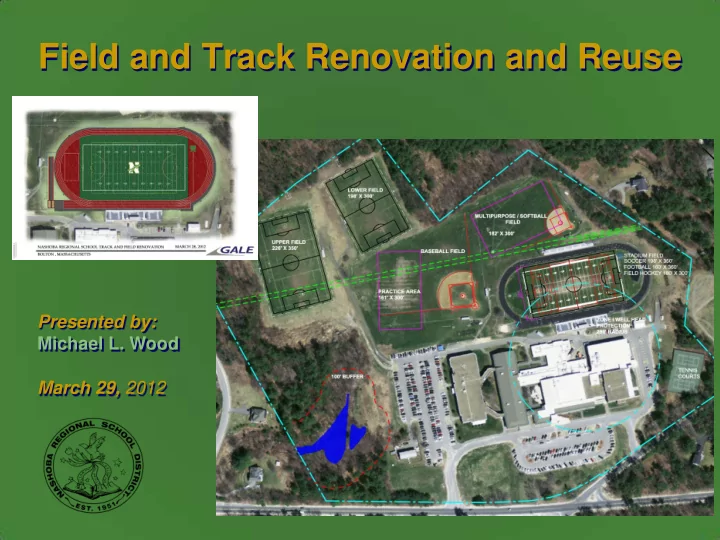

Field and Track Renovation and Reuse Presented by: Michael L. Wood March 29, 2012
Nashoba Regional High School Existing Athletic Facilities
Nashoba Regional High School Condition Evaluation - Track 4 1 2 3 9 7 5 8 6 10 12 11
Nashoba Regional High School Condition Evaluation – Field & Tennis 1 3 6 5 2 4 8 7 9 10 11
Nashoba Regional High School Condition Evaluation – Seating and Accessories 1 3 2 5 6 4
Demand vs. Carrying Capacity 0-200 200-250 > 250
Why Install Synthetic Turf Multi-Purpose Game Field? “Filled” Synthetic Turf Advantages: Dramatically increased use (2-3 X) Allows full use of proposed athletic lighting Very low maintenance Grass-like look and performance All-weather availability Environmentally sensitive Permanent lines and markings Enhanced player safety Pay-to-play opportunities Image/Branding Immediate availability
How Long Will the Carpet Last? How Durable Is the Turf? Today’s infilled carpets expected to last 14 years. UMASS Lowell (the oldest infilled field in New England) used a less durable technology carpet and still lasted 11 seasons of constant use. UMASS Lowell - 1999 UMASS Lowell Users: Football (2 Seasons) UMASS Lowell Use Statistics: Field Hockey – Varsity & JV Soccer – Men & Women 7 Hours/Day (Mon.-Fri.) Lacrosse – Men & Women 12 Hours/Day (Sat.-Sun.) Intramurals 30 weeks per year (May-Nov.) Club Sports 1800 direct use hours per year Community/Youth Sports 18,000 hours over the 10-year life Summer Camps/Clinics 720 events/year @ Baseball Softball 2.5 Hours/Event
Nashoba Regional High School School Committee Adopted Plan
Findings & Conclusions Related To Demand FIELD LOCATION TOTAL ANNUAL USES PROPOSED USES Stadium Field 93 423 *PE not a field demand Baseball Field 470 200 Softball / Multipurpose Field 388 250 Lower Field 302 250 Upper Field 248 235 Front Grass Area 17 0 Total 1518 1358 • Stadium Field use of “93” is artificially low as field can not sustain any additional uses. • Front grass area is used for expansion needs of clubs and softball. • Propose 5 new tennis courts allowing: • 3-singles matches • 2-doubles matches
Findings & Conclusions Related To Potential Revenue Source FIELD LOCATION TOTAL ANNUAL USES PROPOSED USES MAXIMUM SUSTAINABLE USES Stadium Field 93 423 600 *PE not a field demand Baseball Field 470 200 250 Softball / Multipurpose Field 388 250 250 Lower Field 302 250 250 Upper Field 248 235 250 Front Grass Area 17 0 0 Total 1518 1358 1600 (Approx 242 Additional Uses) • At 250 uses grass fields are able to “rest” and remain sustainable. • Existing field repairs and renovations would be managed within the grounds budget and phased over a period of time. • Additional uses on Stadium Field would allow the addition of new student teams and events as well as outside revenue creating events.
Nashoba Regional High School School Committee Adopted Plan • Synthetic Turf Field $ 850,000 • Track Reconstruction and Expansion $ 400,000 • New Stadium Lighting $ 300,000 • New Concessions Building $ 200,000 • Tennis Court Construction $ 200,000 • Site Improvements (Ret. walls, walkways) $ 115,000 • Relocation of Spectator Seating $ 65,000 • Fencing and Accessories $ 80,000 $ 2,210,000
Financial Information • Operating Budget Expense • Approximately $190,000 for each year for 15 years – $190,000 • -25,000 from revenues / ticket sales • -15,000 from revenues / rentals – Leaving $150,000 annually • Approximately – $43,000 Lancaster – $50,000 Bolton – $57,000 Stow – (Based on existing Regional Agreement Formula) – Any fundraising can further reduce this amount on an annual basis
Phasing Plan Criteria • Accomplish the projects which result in the biggest impact first, to set the conditions for the project. • Accomplish the remaining Master Plan elements in order of relative importance, based on projected use. • Attempt to accomplish all elements of the Master Plan in five years, including the current year. • Attempt to balance the District’s expenditure on field renovations throughout the Master Plan implementation period. • Schedule Master Plan elements which only provide for a renovation of an existing field in place, with no change in layout or use, late in the phasing plan.
Phasing Plan Summary LOCATION Summer '12 Fall '12 Spring '13 Summer '13 PHASE I Stadium Field $850,000 Track Reconstruction $400,000 Athletic Lighting $300,000 Site Impovements $50,000 Fencing & Accessories $30,000 Relocate Seating $65,000 PHASE II Tennis Courts $200,000 Site Impovements $15,000 PHASE III Fencing & Accessories $20,000 Concessions Building $200,000 PHASE IV Fencing & Accessories $30,000 Site Impovements $50,000 Total Costs $1,695,000 $215,000 $220,000 $80,000 Total Cost: $2,210,000
Conclusions • Field Capacity Increase of 40% • General Enhancement to Turf Quality • Enhanced Student-Athlete Safety • Reduced Maintenance Costs • Enhanced Environmental Sensitivity • Enhanced Community Asset • Enhanced Imaging and Branding
Plan Summary
Recommend
More recommend